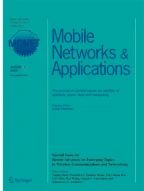Abstract
In this work, we propose a novel intra-flow network coding solution, which is based on the combination of a low overhead Random Linear Coding (RLC) scheme and UDP, to offer a reliable communication service. In the initial protocol specification, the required overhead could be rather large and this had an impact over the observed performance. We therefore include an improvement to reduce such overhead, by decreasing the header length. We describe an analytical model that can be used to assess the performance of the proposed scheme. We also use an implementation within the ns-3 framework to assess the correctness of this model and to broaden the analysis, considering different performance indicators and more complex network topologies. In all cases, the proposed solution clearly outperforms a more traditional approach, in which the TCP protocol is used as a means to offer a reliable communication service.
Similar content being viewed by others
References
The ns-3 network simulator. http://www.nsnam.org/
Ahlswede R, Cai N, Li SY, Yeung R (2000) Network information flow. IEEE Trans Inf Theory 46(4):1204–1216. doi:10.1109/18.850663
Albrecht M (2015) The M4RIE Library—version 20121224. The M4RIE Team. https://bitbucket.org/malb/m4rie
Bianchi G (2000) Performance analysis of the IEEE 802.11 distributed coordination function. IEEE J Sel Areas Commun 18(3):535–547. doi:10.1109/49.840210
Chachulski S, Jennings M, Katti S, Katabi D (2007) Trading structure for randomness in wireless opportunistic routing. SIGCOMM Comput Commun Rev 37(4):169–180. doi:10.1145/1282427.1282400
Feizi S, Lucani D E, Médard M (2012) Tunable sparse network coding. In: Proceedings of the international Zurich seminar on Comm, pp 107–110
Gomez D, Hassayoun S, Herren A, Aguero R, Ros D (2012) Impact of network coding on TCP performance in wireless mesh networks. In: 2012 IEEE 23rd international symposium on personal indoor and mobile radio communications (PIMRC), pp 777–782. doi:10.1109/PIMRC.2012.6362888
Gomez D, Rodríguez E, Agüero R, Muñoz L (2014) Reliable communications over wireless mesh networks with inter and intra-flow network coding. In: Proceedings of the 2014 workshop on Ns-3, WNS3 ’14. ACM, New York, pp 4:1–4:8. doi:10.1145/2630777.2630781
Gomez D, Rodriguez E, Aguero R, Munoz L (2014) Reliable communications over lossy wireless channels by means of the combination of UDP and random linear coding. In: 2014 IEEE symposium on computers and communication (ISCC), pp 1–6. doi:10.1109/ISCC.2014.6912516
Heide J, Pedersen M, Fitzek F, Medard M (2011) On code parameters and coding vector representation for practical RLNC. In: 2011 IEEE international conference on communications (ICC), pp 1–5. doi:10.1109/icc.2011.5963013
Heide J, Pedersen M, Fitzek F, Medard M (2014) A perpetual code for network coding. In: 2014 IEEE 79th vehicular technology conference (VTC Spring), pp 1–6. doi:10.1109/VTCSpring.2014.7022790
Henderson T., Floyd S, GA, Nishida Y (2004) The NewReno modification to TCP’s fast recovery algorithm. Internet RFCs. ISSN 2070-1721 RFC 6582. http://www.rfc-editor.org/info/rfc6582
Ho T, Koetter R, Medard M, Karger D, Effros M (2003) The benefits of coding over routing in a randomized setting. IEEE international symposium on information theory. Proceedings, p 7803. doi:10.1109/ISIT.2003.1228459
Jain R, Chiu DM, Hawe W (1984) A quantitative measure of fairness and discrimination for resource allocation in shared computer systems. Technical Report TR-301. DEC Research Repor
Katti S, Rahul H, Hu W, Katabi D, Médard M, Crowcroft J (2008) XORs in the air: practical wireless network coding. IEEE/ACM Trans Netw 16(3):497–510. doi:10.1109/TNET.2008.923722
Khurshid A, Kabir M, Das R (2015) Modified TCP newreno for wireless networks. In: 2015 international conference on networking systems and security (NSysS), pp 1–6. doi:10.1109/NSysS.2015.7042948
Koetter R, Médard M (2003) An algebraic approach to network coding. IEEE/ACM Trans Netw 11(5):782–795. doi:10.1109/TNET.2003.818197
Krigslund J, Hansen J, Hundeboll M, Lucani D, Fitzek F (2013) CORE: COPE with MORE in wireless meshed networks. In: 2013 IEEE 77th vehicular technology conference (VTC Spring), pp 1–6. doi:10.1109/VTCSpring.2013.6692495
Lefevre F, Vivier G (2000) Understanding TCP’s behavior over wireless links. In: Symposium on communications and vehicular technology, 2000. SCVT-200, pp 123–130. doi:10.1109/SCVT.2000.923350
Li SY, Yeung R, Cai N (2003) Linear network coding. IEEE Trans Inf Theory 49(2):371–381. doi:10.1109/TIT.2002.807285
Luby M (2002) LT codes. In: The 43rd annual IEEE symposium on foundations of computer science, 2002. Proceedings, pp 271–280. doi:10.1109/SFCS.2002.1181950
Lucani DE, Pedersen MV, Heide J, Fitzek FHP (2014) Fulcrum network codes: a code for fluid allocation of complexity. CoRR abs/1404.6620. arXiv:1404.6620
Mascolo S, Casetti C, Gerla M, Sanadidi MY, Wang R (2001) Tcp westwood: Bandwidth estimation for enhanced transport over wireless links. In: Proceedings of the 7th annual international conference on mobile computing and networking, MobiCom ‘01. ACM, New York, pp 287–297. doi:10.1145/381677.381704
Shokrollahi A (2006) Raptor codes. IEEE Trans Inf Theory 52(6):2551–2567. doi:10.1109/TIT.2006.874390
Sorensen C, Lucani D, Fitzek F, Medard M (2014) On-the-fly overlapping of sparse generations: a tunable sparse network coding perspective. In: 2014 IEEE 80th vehicular technology conference (VTC Fall), pp 1–5. doi:10.1109/VTCFall.2014.6966091
Stewart R, Xie Q, Mornmeault K, Sharp H, Taylor T, Rytina I, Kalla M, Zhang L (2000) Stream control transport protocol. Tech. rep., RFC 2960
Sundararajan J, Shah D, Medard M, Mitzenmacher M, Barros J (2009) Network coding meets TCP. In: INFOCOM 2009. IEEE, pp 280–288. doi:10.1109/INFCOM.2009.5061931
Trullols-Cruces O, Barcelo-Ordinas J, Fiore M (2011) Exact decoding probability under random linear network coding. IEEE Commun Lett 15(1):67–69. doi:10.1109/LCOMM.2010.110310.101480
Zorzi M, Chockalingam A, Rao R (2000) Throughput analysis of TCP on channels with memory. IEEE J Sel Areas Commun 18(7):1289–1300. doi:10.1109/49.857929
Acknowledgments
This work has been supported by the Spanish Government by its funding through the project COSAIF, “Connectivity as a Service: Access for the Internet of the Future” (TEC2012-38754-C02-01).
Author information
Authors and Affiliations
Corresponding author
Rights and permissions
About this article
Cite this article
Garrido, P., Gómez, D., Lanza, J. et al. Providing Reliable Services over Wireless Networks Using a Low Overhead Random Linear Coding Scheme. Mobile Netw Appl 22, 1113–1123 (2017). https://doi.org/10.1007/s11036-016-0731-7
Published:
Issue Date:
DOI: https://doi.org/10.1007/s11036-016-0731-7
